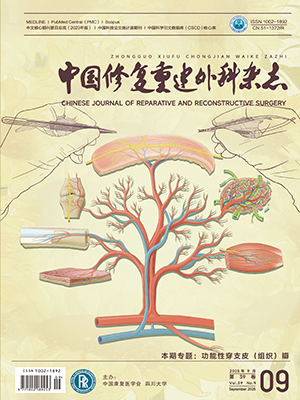| 1. |
Meding JB, Berend ME, Ritter MA, et al. Intramedullary vs extramedullary femoral alignment guides: a 15-year follow-up of survivorship. J Arthroplasty, 2011, 26(4): 591-595.
|
| 2. |
Qin YF, Li N, Shi YX, et al. Intramedullary versus extramedullary alignment guides on total knee arthroplasty: a meta-analysis. J Comp Eff Res, 2018, 7(12): 1181-1193.
|
| 3. |
Feeley I, Hegarty A, Hickey A, et al. Impact of use of intramedullary and extramedullary guides on tibial component geometry in total knee replacements: A systematic review and meta-analysis. J Knee Surg, 2016, 29(6): 487-496.
|
| 4. |
Fukagawa S, Matsuda S, Mitsuyasu H, et al. Anterior border of the tibia as a landmark for extramedullary alignment guide in total knee arthroplasty for varus knees. J Orthop Res, 2011, 29(6): 919-924.
|
| 5. |
Sugimura N, Ikeuchi M, Izumi M, et al. The dorsal pedis artery as a new distal landmark for extramedullary tibial alignment in total knee arthroplasty. Knee Surg Sports Traumatol Arthrosc, 2014, 22(11): 2618-2622.
|
| 6. |
Bilgen O, Bilgen S, Ermutlu C, et al. The extensor hallucis longus tendon as the distal reference point in total knee arthroplasty and tibial alignment. Acta Orthop Traumatol Turc, 2014, 48(3): 271-275.
|
| 7. |
Schneider M, Heisel C, Aldinger PR, et al. Use of palpable tendons for extramedullary tibial alignment in total knee arthroplasty. J Arthroplasty, 2007, 22(2): 219-226.
|
| 8. |
Rajadhyaksha AD, Mehta H, Zelicof SB. Use of tibialis anterior tendon as distal landmark for extramedullary tibial alignment in total knee arthroplasty: an anatomical study. Am J Orthop (Belle Mead NJ), 2009, 38(3): E68-E70.
|
| 9. |
Tsukeoka T, Lee TH, Tsuneizumi Y, et al. The tibial crest as a practical useful landmark in total knee arthroplasty. Knee, 2014, 21(1): 283-289.
|
| 10. |
Nishikawa K, Mizu-uchi H, Okazaki K, et al. Accuracy of proximal tibial bone cut using anterior border of tibia as bony landmark in total knee arthroplasty. J Arthroplasty, 2015, 30(12): 2121-2124.
|
| 11. |
Tsukeoka T, Tsuneizumi Y, Lee TH. Accuracy of the second metatarsal as a landmark for the extramedullary tibial cutting guide in total knee arthroplasty. Knee Surg Sports Traumatol Arthrosc, 2014, 22(12): 2969-2974.
|
| 12. |
贺强, 马建兵, 孙相祥. 胫骨内翻畸形对全膝关节置换术胫骨假体对线影响的临床研究. 实用骨科杂志, 2017, 23(7): 583-588.
|
| 13. |
赵旻暐, 田华, 曾琳, 等. 中国人采用胫骨结节及胫前肌腱定位的髓外截骨法术后胫骨假体冠状位力线的测量与分析. 北京大学学报 (医学版), 2016, 48(2): 351-355.
|
| 14. |
Yau WP, Chiu KY, Tang WM, et al. Coronal bowing of the femur and tibia in Chinese: its incidence and effects on total knee arthroplasty planning. J Orthop Surg (Hong Kong), 2007, 15(1): 32-36.
|
| 15. |
Chiu KY, Yau WP, Ng TP, et al. The accuracy of extramedullary guides for tibial component placement in total knee arthroplasty. Int Orthop, 2008, 32(4): 467-471.
|
| 16. |
Saibaba B, Dhillon MS, Chouhan DK, et al. Significant incidence of extra-articular tibia vara affects radiological outcome of total knee arthroplasty. Knee Surg Relat Res, 2015, 27(3): 173-180.
|
| 17. |
吴伟, 郭万首. 下肢全长X线检查的临床应用及其精准性的研究进展. 中华骨与关节外科杂志, 2017, 10(1): 83-87.
|
| 18. |
Shao J, Vail TP, Qiao-Jie W, et al. Anatomical references for tibial sagittal alignment in total knee arthroplasty: A comparison of three anatomical axes based on 3D reconstructed CT images. Chin Med, 2013, 126(20): 3840-3844.
|
| 19. |
刘恒, 李卓扬, 曹永平, 等. 胫骨侧徒手截骨的膝关节置换术后力线测量及其影响因素分析. 北京大学学报 (医学版), 2018, 50(5): 89-93.
|
| 20. |
Dror P. Principles of deformity correction. Berlin: Springer Science & Business Media, 2002: 2-5.
|
| 21. |
Palanisami D, George MJ, Hussain AM, et al. Tibial bowing and tibial component placement in primary total knee arthroplasty in valgus knees: Are we overlooking? J Orthop Surg (Hong Kong), 2019, 27(3): 2309499019867006. doi: 10.1177/2309499019867006.
|




